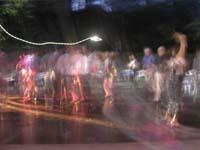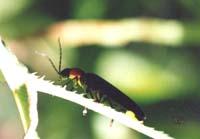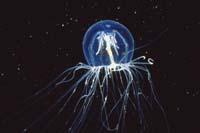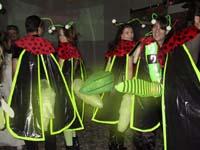Fireflies of festivities

Although the most extended tubes in the holidays are the flexible tubes that are placed around the neck or head, there are many colors and shapes, and are not used only to brighten the parties. In much more serious situations they are of great help, for example, to indicate an accident or to highlight the emergency exit. In any case, these devices are based on chemoluminescence.
In nature there are beings that produce light. This feature is called bioluminescence and the clearest example is the firefly. In the sea are many living beings that emit light: fish, worms, corals, jellyfish... This capacity acquired the attention of man long ago, but until recently it has not been known how they worked. When scientists discovered the mystery, they saw that fireflies were much more effective than man-made light bulbs.

The secret of the firefly
Luciernaga, with a light-generating device in the ventral zone, uses only the substance luziferin, the enzyme luziferase and the oxygen of the air to obtain light. The oxygen, which reaches this special apparatus through tubes in the trachea, and with the participation of the enzyme luziferase, oxidizes the luciferin. The energy needed for the reaction is provided by the ATP molecule. Then, the oxidized luciferin is spontaneously decomposed, obtaining on one side the initial luciferin and oxygen, and on the other, releasing to light the energy supplied by the molecule of ATP.
The reaction is very effective, so the abdomen is not heated. On the contrary, the bulbs are very hot, in fact, two thirds of the energy they receive is released in the form of heat and only one third becomes light.
The first steps to get the version of the firefly were taken in the 60s. The scientists knew what they needed: a molecule that emits light when excited and an energy source to excite it. There are many energy sources available: light, heat, electricity... In chemoluminescence, the energy source is a chemical reaction. The hardest thing was to find a reaction without energy loss.

Edwin A worked at the same time at Bell Laboratories. The young Chandross was rehearsing to understand chemoluminescence. In their opinion, the peroxides played an important role, since they are able to release much energy in some chemical reactions. After many experiments, he discovered that the mixture of oxalyl chloride with oxygenated water and a fluorescent dye produced light. However, Chandross did not recognize the potential of the reaction and did not patent it.
Other chemicals, for their part, acted faster and, upon learning of Chandross's discoveries, tried to take advantage of it. From this path, the chemist Rauhut found a phenyloxalate ester that released enough light in the reaction.
Cold light in a tube
At present, companies producing products based on chemoluminescence continue to apply this reaction. When reacting the ester of oxalate and oxygenated water, other chemical substances are generated that, when decomposing, release a lot of energy. Finally, this energy excites the coloring molecule, giving rise to fluorescence.

The reaction occurs in a closed place and, because there is no heat, it can be used by children. To start up the reaction, you have to bend or break the tube or cane, thus putting in contact the chemicals. The light lasts between 6 and 7 hours and depending on the coloring light is emitted from one color or another. The easiest colors to get in the industry are yellow and green, while red and blue are very difficult and the most difficult is purple, a mix of three colors.
Besides getting more colors and more beautiful, the main challenge of chemicals is to improve efficiency. In fact, in chemoluminescence many more steps are taken than in the enzymatic reaction of the firefly, so its degree of efficacy has not been achieved. It seems that nature remains more powerful than chemistry
Published in 7K.
Buletina
Bidali zure helbide elektronikoa eta jaso asteroko buletina zure sarrera-ontzian











